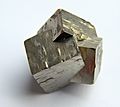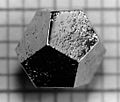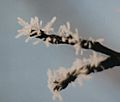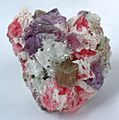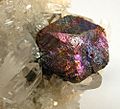Crystal facts for kids
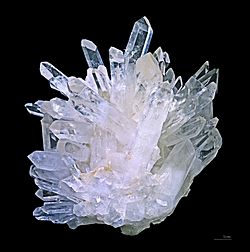
A crystal is a special kind of solid material. Imagine tiny building blocks, like atoms, molecules, or ions, all neatly lined up in a repeating pattern. This pattern creates a strong, organized structure called a crystal lattice. Because of this neat arrangement, many crystals have flat, smooth sides and specific shapes you can recognize. The scientific study of crystals and how they form is called crystallography.
The word crystal comes from an Ancient Greek word, krustallos. This word meant both "ice" and "rock crystal". This is because ice often forms beautiful, clear crystals.
You can find crystals all around you! Some common examples are snowflakes, shiny diamonds, and even the table salt you use for cooking.
Where Do We Find Crystals?
Crystals are super common on Earth. A huge amount of the Earth's solid bedrock is made of crystals. Most crystals found in rocks are quite small, usually from a tiny bit of a millimeter to several centimeters across.
But sometimes, really huge crystals are found! As of 1999, the biggest natural crystal ever found was a beryl crystal in Madagascar. It was an amazing 18 meters (about 59 feet) long and 3.5 meters (about 11.5 feet) wide. It weighed a massive 380,000 kilograms (about 837,757 pounds)!
Other crystals form from liquids, often water. For example, quartz veins in rocks are created when water carrying minerals flows through cracks and then the minerals crystallize. Water-based ice is also a very common crystal. Think of snow, sea ice, and glaciers. Each snowflake is usually a single crystal, while an ice cube is made of many tiny crystals stuck together.
What is Crystallography?
Crystallography is the science that studies crystals. It helps us understand the exact arrangement of atoms inside a crystal. Scientists use special tools, like X-ray diffraction, to figure out these tiny structures. All the information about known crystal structures is kept in special crystallographic databases.
Images for kids
-
Ice crystals
-
Vertical cooling crystallizer in a beet sugar factory.
-
Twinned pyrite crystal group.
-
The material holmium–magnesium–zinc (Ho–Mg–Zn) forms quasicrystals, which can take on the macroscopic shape of a pentagonal dodecahedron. Only quasicrystals can take this 5-fold symmetry. The edges are 2 mm long.
-
Insulin crystals grown in earth orbit.
-
Hoar frost: A type of ice crystal (picture taken from a distance of about 5 cm).
-
Gallium, a metal that easily forms large crystals.
-
Boules of silicon, like this one, are an important type of industrially-produced single crystal.
See also
 In Spanish: Cristal para niños
In Spanish: Cristal para niños







